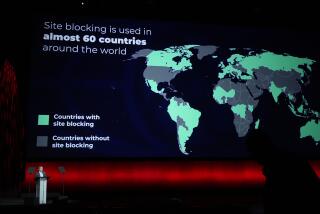Competing with the pirates
In October 2005, Apple added downloadable television shows to its popular iTunes Store. The move jump-started the market for full-length TV shows online, and by January 2008, the store had sold more than 125 million episodes. In the meantime, though, a curious thing happened: Instead of seeing how much money they could collect from $1.99 downloads, the major networks made more of their shows available online for free.
Today, most of broadcast TV’s prime-time shows and many of the programs on cable networks can be watched online for free, with advertisers footing the bill. It’s not too surprising that broadcasters would go that route; after all, it lines up well with the business model they’ve used over the air for decades. What’s unusual is that they would do so without the multiple layers of protection against piracy that the entertainment industry typically demands online.
To be sure, they want their online partners to try to stop piracy, and as recent announcements from Adobe and Widevine attest, the techniques for protecting video streams are improving. Still, to the studios’ credit, they haven’t waited on the sidelines while technology companies perfected their electronic locks. They put their shows out there and tried to build an audience for them online.
The main threat to advertiser-supported video businesses is that pirates would copy and redistribute the programs without commercials (or even with commercials, if the business can’t track how many people saw the ads). The more unlicensed outlets there are for a program, the harder it is for an industry-authorized site to attract the audience needed to lure advertisers and generate profits. The companies that make streaming video technology, including Adobe, Microsoft and Apple, have developed ways over the years to scramble programs while they’re being piped across the Net, but they’ve had a hard time overcoming “stream ripping” software that records video as it’s being played.
Adobe, whose Flash technology is the leading method for streaming video, unveiled an update in September 2005 that was designed to block a popular method of copying streams. But it remained vulnerable to other recording techniques, and a number of software companies offered products that could take advantage of the holes in its defenses.
A few years ago, that vulnerability would have been enough to stop the studios from using Flash. Darren Feher, NBC Universal’s chief technical officer, said his company wouldn’t even have experimented with a method for online distribution “unless it met this definition of perfect.” Like much of Hollywood, NBC Universal was using only Microsoft’s Windows Media software for streams because it included digital rights management technology that set limits on copying and playback. But in the past 18 months or so, the studio shifted its strategy and focused on getting its programming in front of the largest possible audience. That meant switching from Windows Media, which didn’t work on millions of Macs and other non-Windows devices, to the ubiquitous Flash, which works on a variety of operating systems and devices. Other major networks and TV studios have made the same choice.
To some extent, the move was a concession to reality. By the time a television show was offered online -- typically the day after it aired -- the original broadcast had already been recorded and redistributed widely. The networks needed to combat this bootlegging with a legitimate, free alternative that could recapture and monetize some online viewers. Nevertheless, the networks and studios pressed for more protection even as they made more content available in more places on the Net.
So far, Adobe has delivered a new version of its Flash server that allows users to save files on their computers for later viewing, but with more protection against copying. The bits remained scrambled all the way to Adobe’s media player, said Laurel Reitman, a senior product manager at Adobe. Still, she conceded that the company hasn’t solved the pesky problem of video being captured as it appears on the screen. “It’s a real big challenge within the industry,” Reitman said.
Widevine goes further, offering ways to stop computers from recording Flash and Silverlight streams as they play. Chief Executive Brian Baker explained that the company monitors “the underlying behavior” of a computer to detect when a stream is being copied. Its software can respond by stopping the stream, degrading the signal or asking the user to stop the recording, he said. Studio executives say the technology isn’t perfect, but they like what they’ve seen so far.
Regardless of the improvements, some studios remain skittish enough about piracy that they won’t make certain types of content available without some additional protection against copying -- for example, ad-supported downloads that could be transferred to a portable device, or feature films in high definition. But Feher said those capabilities will come soon enough, once the business-model and bandwidth hurdles are overcome. Besides, the underground market for video online is already brimming with high-definition bootlegs made from over-the-air broadcasts. The networks are already competing with that, ready or not.
Jon Healey is a Times editorial writer; he runs the Bit Player blog. Respond at [email protected].
More to Read
A cure for the common opinion
Get thought-provoking perspectives with our weekly newsletter.
You may occasionally receive promotional content from the Los Angeles Times.











